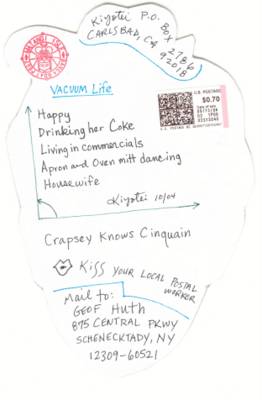This card is another surprise from kiyotei, who experiments with methods of creation and forms of work all the time. Even given his past surprises, I was amazed that kiyotei created this piece. He took the image of Lucille Ball as housewife and created a cinquain about housework on the back. Not only that, though: he also made a reference to Adelaide Crapsey, a minor poet most famous for creating the cinquain, an American form based on the "syllable"-count Japanese poetic forms (haiku and tanka).
kiyotei writes a poem using the original cinquain form (a 2-4-6-8-2 syllable count that somehow always reminds me of the shape of the Shakespearean sonnet). The form most people learn is a weird and deadly transmogrification created by English teachers to teach kids the parts of speech. These horrible cinquains consist of five word-counted lines in this pattern: one noun, two adjectives, three gerunds (AKA "verbs"), four adverbs (as I learned it), and another single noun.
If I weren't lazy right now, I'd go up to the third floor, and pull out my archives to find the cinquains I wrote in the eighth grade in Calacoto, Bolivia. But lacking that, enjoy kiyotei's work, not just the poem, but the right-angled bracket for the poem, the Matangi Isle postmark, etc.

kiyotei, "Vaccuum Life" (Oct 2004)
un violon d'ingres
No comments:
Post a Comment